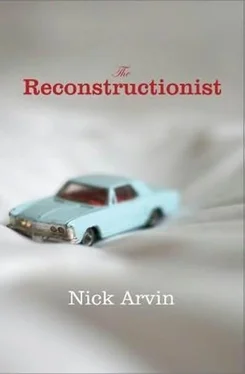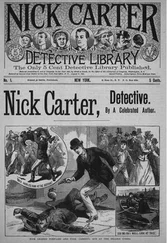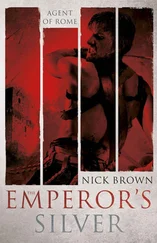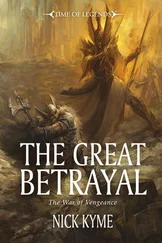It was from a Toyota Tacoma pickup that had carried on its bed a home-made camper sided with wooden shingles. In the midst of a snowstorm it had slid off the roadway and mired here in snow. A tow truck had come out to help. And the tow-truck driver was killed when a semi came off the roadway, slid through the snow and pulverised his upper torso against the back of the Toyota – like fingers in a stamping press. In the police photos that Ellis had studied, nothing could be seen of the man except for the blood smeared over the two surfaces that had killed him and a single booted foot extended from beneath the semi. When Boggs saw it he said, ‘Like the witch in Oz .’ Using photogrammetric techniques, Ellis had analysed a stack of police Polaroids of tyre marks in the snow to prove that the tow truck had been parked fully on the shoulder and not in the highway’s right lane, as the semi driver claimed.
After the shingle, finding nothing more, Ellis drifted into abstraction, staring at a runnel-fed low place a short distance away, full of cattails and redwing blackbirds that moved in bursts and called in trills. The humid atmosphere resonated with the yellow-white hammering of the sun.
Finally he walked up the acceleration ramp and down the road to the building with the howitzer.
It had a concrete parking lot with crabgrass flaring from the cracks. Here and there lay a few scattered cinder blocks. A plastic lawn chair tilted on a broken leg. The building’s windows were glass block, and Ellis could see nothing in them. He knocked, and a stout, blue-eyed man of seventy or so opened the door immediately – as if he had been waiting – and said hello.
Ellis said hello and the man nodded and shook hands earnestly and said hello again. ‘I’m sorry to bother you,’ Ellis said.
‘So you know,’ the man said, ‘this hadn’t been a VFW post for the fifteen years since I bought it from the VFW. I never have gotten around to painting.’ He scuffed a head of crabgrass with his foot. He wore a brown T-shirt marked with Harvey Mudd College and a pendant oblong of sweat. He said, ‘My wife, now in heaven, always said a man living alone would forget how to live in the world. But I don’t give a damn, I don’t have anyone to impress.’ He had his hands in the pockets of his jeans and held his elbows flared out.
‘A while back,’ Ellis said, ‘I did some engineering work on an accident that occurred down there by the ramp. Do you know the one I mean?’
‘You’re an engineer? I used to design ball-peening systems. I designed ball-peening machines for GM and ball-peening machines for Ford and ball-peening machines for Boeing and ball-peening machines for the National Mint. Do you know about the famous eleventh-century swords of Toledo – not Ohio! – Spain? They could be bent almost double and they would spring right back, good as new. Guess how they did it?’ The old man stood happy and flexing his hands.
‘Ball-peening?’
‘Ball-peening!’ the old man exclaimed. ‘The guys who knew how to do it took the secret of it to their graves and the idea was lost for a thousand years, until GM tried blasting their springs clean with steel shot instead of sand. They lasted longer! Ball-peening!’ He bounced on his feet and leered. ‘I saved the Feds millions of dollars when I showed them how to peen the money-printing dies. I told them that they could take it out of my taxes. Guess what happened to my taxes.’
Ellis felt his feet sweating in his shoes. ‘What?’
‘Nothing!’
‘I’m looking for a friend of mine,’ Ellis said.
‘The gentleman in the green convertible?’
Ellis lifted his hands but stopped short of grabbing the man. ‘When was he here?’
‘Yesterday afternoon, stereo blasting some book at top volume.’
‘Did you recognise the book? What did the driver look like?’
‘Never took to books. Driver seemed like, I’d say, a man in a convertible – sunburned, wind-blown. He asked about this accident, the one that you mentioned. The guy, Chuck, who died there, was someone I’d seen a couple of times. At the Cracker Barrel at breakfast. He was a grits-and-gravy guy. Personally, I hate grits.’ He sucked his lips and looked around as if he regretted this last comment. A single haggard willow stood behind the VFW building, its branches low and trailing in circles under the pawing of a breeze. Traffic ran steady and fast on the interstate lanes. ‘I didn’t know what had happened at first. From here all you could see was the flashing lights, the red and the blue, bouncing off the falling snow, colouring that part of the sky. The snow had been coming and going all morning. So I walked a little closer. It was a horrible mess. I stood above it, and I didn’t know exactly what had happened, but an ambulance came, and I could see it was bad. I remember thinking it seemed strange, that mess, someone dead maybe, I didn’t know yet, and all around it was a really beautiful morning. The air had that edge in it, that cleanness, like you should bottle some for later. A clear blue sky coming out of the clouds, sky the colour of those original powder-blue Ford T-birds, the ones with the porthole side windows. And these hills are pretty in winter, white, rolling. I never get tired of them. My footprints in the snow looked like the footprints of the last man on earth. I remember I thought, it’s bad down there, but it’s nothing to do with me. Nothing to do with me and I feel fine, just fine, I thought, by God, I’m happy. I hadn’t had a clear feeling like that in a long time. Course it turned out it did have something to do with me, as I knew Chuck a little, and I felt pretty bad about it then.’
They stood looking at the traffic. A convoy of five semis. A Prius.
‘Funny how you think things like that,’ he added.
Ellis made himself speak and asked a few more questions about Boggs – had he seen which way Boggs had gone, or paid any attention to the condition of the convertible? – but learned nothing. ‘I explained to your friend that ball-peening is badly neglected at most of the major engineering schools.’
Ellis excused himself and returned to the accident site. He’d not noticed anything beautiful about it, which made him think he might have missed something. He scuffed around until a thought came, and he went back up the ramp and knocked and asked where Boggs had parked the convertible.
‘About there,’ he said, pointing.
One tyre had made a light impression in the soil. With a pen, on the back of a receipt, Ellis sketched the pattern of the tyre print. He stared at it to try to brand it into his mind. Then he took out his map again, thinking, I’ll never catch up by following him. I need to jump ahead.
IN FRANCE, LATE in the reign of Louis XV, a man named Nicolas-Joseph Cugnot devised the world’s first automobile, a steam-powered wagon. Cugnot called it a fardier à vapeur . Equipped with wagon wheels, a kettle-shaped steam generator and a tiller – the driver steered as if piloting a boat – it could accelerate to speeds as high as 2.5 mph. Perhaps inevitably, having invented the fardier à vapeur , Cugnot also invented the car crash, when he drove the fardier à vapeur into a wall. Although no one was hurt, Cugnot lost his research funding.
So Ellis reported to Boggs during a plane flight. ‘Thank God,’ Boggs said, ‘ fardier à vapeur isn’t a term that’s stuck.’
Ellis had started the research out of simple curiosity, but Boggs had encouraged him – a good anecdote might be useful in court some day. Ellis went on: more than one hundred years elapsed before the first fatal automotive accident occurred. In 1896 a woman named Bridget Driscoll was strolling with her daughter on the grounds of London’s Crystal Palace when she was struck and killed by an Anglo-French Motor Car Company vehicle. Witnesses reported the Anglo-French vehicle was travelling at a ‘tremendous speed’, later estimated to be 4 mph.
Читать дальше












